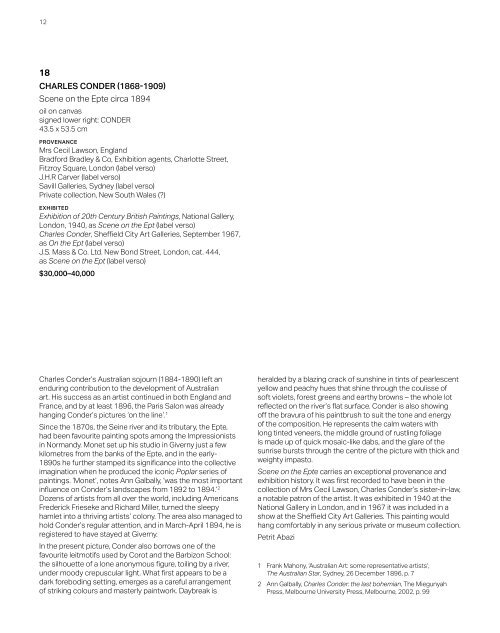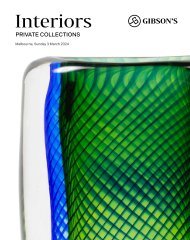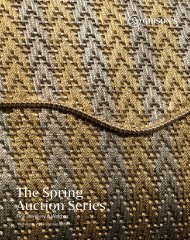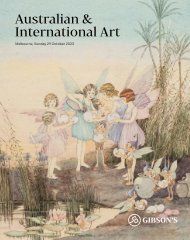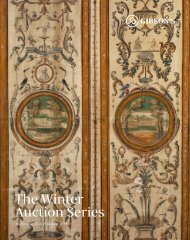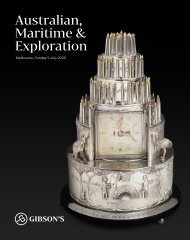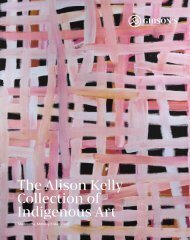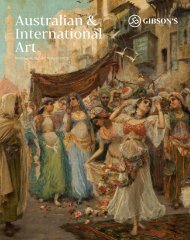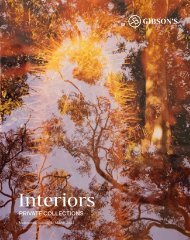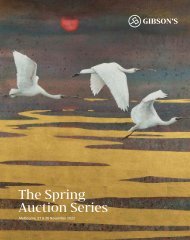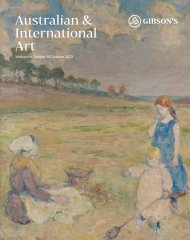GA023 - Australian and International Art
GA023 - Australian and International Art
GA023 - Australian and International Art
- No tags were found...
You also want an ePaper? Increase the reach of your titles
YUMPU automatically turns print PDFs into web optimized ePapers that Google loves.
12<br />
18<br />
CHARLES CONDER (1868-1909)<br />
Scene on the Epte circa 1894<br />
oil on canvas<br />
signed lower right: CONDER<br />
43.5 x 53.5 cm<br />
PROVENANCE<br />
Mrs Cecil Lawson, Engl<strong>and</strong><br />
Bradford Bradley & Co, Exhibition agents, Charlotte Street,<br />
Fitzroy Square, London (label verso)<br />
J.H.R Carver (label verso)<br />
Savill Galleries, Sydney (label verso)<br />
Private collection, New South Wales (?)<br />
EXHIBITED<br />
Exhibition of 20th Century British Paintings, National Gallery,<br />
London, 1940, as Scene on the Ept (label verso)<br />
Charles Conder, Sheffield City <strong>Art</strong> Galleries, September 1967,<br />
as On the Ept (label verso)<br />
J.S. Mass & Co. Ltd. New Bond Street, London, cat. 444,<br />
as Scene on the Ept (label verso)<br />
$30,000–40,000<br />
Charles Conder’s <strong>Australian</strong> sojourn (1884-1890) left an<br />
enduring contribution to the development of <strong>Australian</strong><br />
art. His success as an artist continued in both Engl<strong>and</strong> <strong>and</strong><br />
France, <strong>and</strong> by at least 1896, the Paris Salon was already<br />
hanging Conder’s pictures ‘on the line’. 1<br />
Since the 1870s, the Seine river <strong>and</strong> its tributary, the Epte,<br />
had been favourite painting spots among the Impressionists<br />
in Norm<strong>and</strong>y. Monet set up his studio in Giverny just a few<br />
kilometres from the banks of the Epte, <strong>and</strong> in the early-<br />
1890s he further stamped its significance into the collective<br />
imagination when he produced the iconic Poplar series of<br />
paintings. ‘Monet’, notes Ann Galbally, ‘was the most important<br />
influence on Conder’s l<strong>and</strong>scapes from 1892 to 1894.’ 2<br />
Dozens of artists from all over the world, including Americans<br />
Frederick Frieseke <strong>and</strong> Richard Miller, turned the sleepy<br />
hamlet into a thriving artists’ colony. The area also managed to<br />
hold Conder’s regular attention, <strong>and</strong> in March-April 1894, he is<br />
registered to have stayed at Giverny.<br />
In the present picture, Conder also borrows one of the<br />
favourite leitmotifs used by Corot <strong>and</strong> the Barbizon School:<br />
the silhouette of a lone anonymous figure, toiling by a river,<br />
under moody crepuscular light. What first appears to be a<br />
dark foreboding setting, emerges as a careful arrangement<br />
of striking colours <strong>and</strong> masterly paintwork. Daybreak is<br />
heralded by a blazing crack of sunshine in tints of pearlescent<br />
yellow <strong>and</strong> peachy hues that shine through the coulisse of<br />
soft violets, forest greens <strong>and</strong> earthy browns – the whole lot<br />
reflected on the river’s flat surface. Conder is also showing<br />
off the bravura of his paintbrush to suit the tone <strong>and</strong> energy<br />
of the composition. He represents the calm waters with<br />
long tinted veneers, the middle ground of rustling foliage<br />
is made up of quick mosaic-like dabs, <strong>and</strong> the glare of the<br />
sunrise bursts through the centre of the picture with thick <strong>and</strong><br />
weighty impasto.<br />
Scene on the Epte carries an exceptional provenance <strong>and</strong><br />
exhibition history. It was first recorded to have been in the<br />
collection of Mrs Cecil Lawson, Charles Conder’s sister-in-law,<br />
a notable patron of the artist. It was exhibited in 1940 at the<br />
National Gallery in London, <strong>and</strong> in 1967 it was included in a<br />
show at the Sheffield City <strong>Art</strong> Galleries. This painting would<br />
hang comfortably in any serious private or museum collection.<br />
Petrit Abazi<br />
1 Frank Mahony, ‘<strong>Australian</strong> <strong>Art</strong>: some representative artists’,<br />
The <strong>Australian</strong> Star, Sydney, 26 December 1896, p. 7<br />
2 Ann Galbally, Charles Conder: the last bohemian, The Miegunyah<br />
Press, Melbourne University Press, Melbourne, 2002, p. 99


